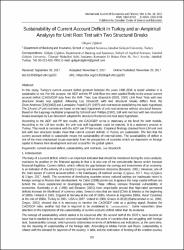Sustainability of Current Account Deficit in Turkey and an Ampirical Analysys for Unit Root Test with Two Structural Breaks
Özet
In this study, Turkey’s current account deficit problem between the years 1980-2016 is tested whether it is sustainable or not. For this purpose, the ADF and the PP Unit Root test were applied firstly to the annual current account deficit (CAD)/GDP data from the IMF. Then, Lee Strazicich (2003, 2004) Unit Root Tests with two structural breaks was applied. Allowing Lee Strazicich with two structural breaks differs from the Zivot-Andrews (ZA)(1992) and Lumsdaine-Papell (LP) (1997) unit root tests in establishing the basic hypothesis. The ZA and LP unit root tests are based on the basic hypothesis of unit root existence without structural fracture. Based on the Lagrange multiplier proposed by Schmidt and Phillips (1992), LM unit root test with two structural breaks developed by Lee-Strazicich adopted the structural fractured unit root basic hypothesis. According to the ADF and PP test results, the CAD/GDP series is stationary at the level for both models. According to the LM test results, the unit root null hypothesis could be rejected. It is a stationary process in Turkey. This result is consistent with the ADF and PP test results. Empirical findings obtained from LM unit root test with two structural breaks show that current account deficits in Turkey are sustainable. The fact that the current account deficit is sustainable means the sustainability of external debts. The sustainability of deficit is one of the most emphasized issues especially from the perspective of countries which are dependent on foreign capital to finance their development and also crucial for the global system.
Cilt
9Sayı
12Bağlantı
http://hdl.handle.net/11363/1121Koleksiyonlar
Aşağıdaki lisans dosyası bu öğe ile ilişkilidir:


















